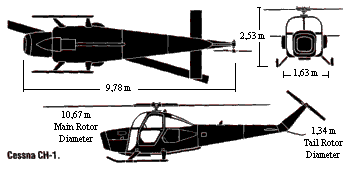
""
CESSNA
AIRCRAFT
|
CESSNA
CH-1 |


|
|
|
Después
de adquirir, el 1 de marzo de 1952 a la compañía Siebel Helicopter
Company, también con base en Wichita, Kansas, Cessna conservó a su
fundador, Charles Siebel, como ingeniero jefe de la recién creada
Cessna Helicopter División. Ese mismo año comenzaron los trabajos de
dicha división; se trataba de un helicóptero biplaza íntegramente metálico
y del todo convencional, en configuración de rotor principal y rotor de
cola, dotado de una cómoda cabina cerrada y tren de aterrizaje con esquíes.
La característica mas avanzada de este diseño consistía en la
instalación de la planta motriz en el morro del fuselaje, lo que
permitía disponer de una cabina muy mejorada. El primer ejemplar, con
la denominación Cessna CH1, voló en el mes de julio de 1954. Se han construido unos 20 Skyhooks, cuatro o cinco en versión militar los cuales algunos fueron a Sud América. Un único ejemplar denominado YH-41 fue adquirido por el US Army para evaluación. |
|
|
|
Skyhook, new entry in the commercial market, will cost $79,960 in four-place configuration. Skyhook is certificated for cruising speeds up to 122 mph. First deliveries are expected to be made in 1961. (Text from Aviation Week October 17, 1960) Cessna Aircraft Co. is discontinuing production of its Skyhook helicopter because a thorough study of the rotary wing aircraft market by the company indicates that the use of the helicopter for business and utility purposes has not been developing as anticipated earlier. Cessna entered the rotary wing field in l952 when it acquired Seibel Helicopter Co. It has developed about 20 Skyhooks including four or five military versions which went to South America. (Text from Aviation Week January 7, 1963) Shortly after its 1952 acquisition of the Seibel Helicopter Company, Cessna undertook development of an innovative light helicopter it designated the CH-1. The aircraft made its maiden flight in 1954, and in 1957 the Army purchased ten examples of the advanced commercial model CH-1B for test and evaluation. These machines, serials 56-4236 through -4245, were allocated the designation YH-41. The YH-41 was of all-metal construction and provided seating for a pilot and up to three passengers in a cabin closely resembling that of one of Cessna's light fixed-wing aircraft. The Seneca was powered by a single nose-mounted 260hp supercharged Continental piston engine driving the two-bladed main and anti-torque rotors via a shaft which passed between the two forward seats. The Army's evaluation of the YH-41 showed it to be an excellent high altitude performer, though the type's limited payload and rather complex maintenance requirements precluded its large scale procurement by the Army. The ten YH-41’s were eventually relegated to miscellaneous flight test duties, most having to do with high-altitude helicopter operations, and in 1962 the surviving aircraft were redesignated NH-41A’s. S.Harding "U.S.Army Aircraft since 1947", 1990 |
|
|
|
Characteristics |
Information |
Characteristics |
Information |
| First
Flight Primer Vuelo |
1954 |
Engine Motor |
1
Continental |
| Seating
Capacity Plazas |
1 / 1 |
Power Potencia |
260 HP |
| Empty
Weight Peso Vacío |
896 Kg |
Hover
Ceiling O.G.E. Estacionario O.G.E |
Mt |
| Maximum
Weight Peso Máximo |
1361 Kg |
Hover
Ceiling I.G.E. Estacionario I.G.E |
2300 Mt |
| Vel.
Cruise Vel. crucero |
85 Kts |
Service
Ceiling Techo de Servicio |
4500 Mt |
| V.N.E. V.N.E |
105 Kts |
Maximum
Range (Std) Alcance (Std) |
234 NM |
Copyright © 1999 / 2003